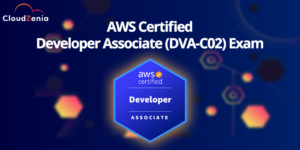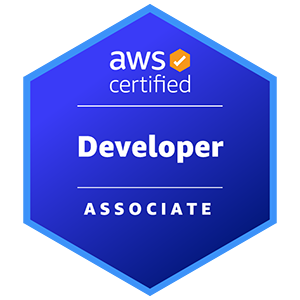
In this blog, we will explain how to pass the AWS Certified Developer – Associate exam. This might help you in your journey to pass the exam.
Enjoy!

Who Should Take This Exam?
AWS Certified Developer – Associate is a great starting point on the AWS Certification path for individuals who may have any of the following:
-
- Experience working in a developer role with in-depth knowledge of at least one high-level programming language.
-
- Experience in AWS technology.
-
- Strong on-premises IT experience and understanding of mapping on-premises to cloud.
-
- Experience working in other cloud services.
The exam also validates a candidate’s ability to complete the following tasks:
-
- Develop and optimize applications on AWS.
-
- Package and deploy, by using continuous integration and continuous delivery (CI/CD) workflows.
-
- Secure application code and data.
-
- Identify and resolve application issues.
Understanding the AWS Certified Developer Associate Exam
| Exam duration | 130 minutes |
| Exam format | 65 questions; either multiple-choice or multiple-response |
| Cost | 150 USD |
| Test in-person or online | Pearson VUE testing center or online proctored exam |
Step 1: Get to Know the Exam and Exam-Style Questions
The AWS Certified Developer Associate exam includes 65 questions and has a time limit of 130 minutes.
A minimum score of 720 out of 1000 points is required to pass the exam.
Response types:
There are two types of questions on the exam:
-
- Multiple choice: This type consists of one correct answer and three incorrect options (distractors).
-
- Multiple responses: This type requires selecting two or more correct answers from five or more options.
Most questions are 1-2 lines of a scenario followed by the actual question itself. For example, you may be asked to select the most secure, most cost-effective, or most operationally efficient option.
Step 2: Learn about the Exam Topics
The exam has the following content domains and weightings:
-
- Domain 1: Development with AWS Services (32% of scored content)
-
- Domain 2: Security (26% of scored content)
-
- Domain 3: Deployment (24% of scored content)
-
- Domain 4: Troubleshooting and Optimization (18% of scored content)
You can also have a look at the official exam guide provided by AWS.
Step 3: Prepare for Your Exam
There are various courses where you can enrol, both on Udemy and on YouTube. AWS also offers various training options, including instructor-led classes, online courses, and self-paced tutorials. The highest-rated course on Udemy for AWS Developer Associate Certification is Stephane Mareek’s Udemy Course. He also has a practice test where you can enrol or you can also watch this free YouTube Video.
Step 4: Putting Theory into Practice
Now, it’s time to do hands-on practice on the actual AWS Console. Create your free account on AWS. AWS offers new customers a 12-month free tier when they create an account. This tier includes three types of offerings: 12 months free, always free, and short-term free trials.
Some Important Services to Focus on for DVA-C02:
-
- Make sure you are proficient in integrating Amazon EC2 with ELBs and Auto Scaling.
-
- Learn about the situations where AWS Elastic Beanstalk is a better fit than alternative compute solutions or infrastructure-as-code technologies like CloudFormation or OpsWorks.
-
- Examine how to include Amazon ECS into a CI/CD pipeline to expedite deployment procedures.
-
- Examine your options for integrating AWS Lambda with other services and learn how to use Lambda functions to record and process incoming events.
-
- Amazon RDS/Amazon Aurora: Understand how Amazon RDS integrates with your application, whether through EC2, ECS, Elastic Beanstalk, or other services.
-
- Amazon DynamoDB: Dive into the DynamoDB documentation, which provides more detailed and informative content than the FAQs.
-
- Amazon S3 is frequently the first option when it comes to object storage. Examine the many approaches to object security in S3, including bucket policies, ACLs, and KMS encryption.
-
- Amazon EFS is employed to establish file systems for multiple EC2 instances.
-
- Amazon Kinesis: Familiarize yourself with Kinesis APIs, sharding concepts, and integration aspects with storage services like S3 and compute services such as Lambda.
-
- Understand the architecture of Amazon API Gateway, including ideas about stages, methods, and resources. Examine the options for integrating with other AWS services, including CloudFront or Lambda.
-
- Amazon Cognito: Cognito is frequently mentioned in test questions, particularly when discussing situations requiring web and mobile authentication, Lambda, API Gateway, and DynamoDB.
-
- Amazon SQS: Investigate timeouts, learn about the features of different SQS queues, and look at how messages are handled in queues.
-
- Amazon CloudWatch: CloudWatch is the main tool you use to monitor AWS services. Make sure you are aware of the metrics that CloudWatch monitoring offers and determine which metrics call for installing a CloudWatch agent.
-
- Your cloud environment’s security center is Amazon IAM. It is essential that you familiarize yourself with the many IAM features.
-
- AWS CodeBuild/AWS CodeCommit/AWS CodeDeploy/AWS CodePipeline: These tools are essential for implementing Continuous Integration/Continuous Deployment (CI/CD) in AWS. Pay particular attention to learning how to use build specifications (Buildspec) to design apps in CodeBuild. Learn how to generate CodeDeploy configuration files (AppSpec) as well. Given that CodeCommit is a Git repository, it is beneficial to know Git. To get knowledge about efficient code deployment management, think about creating a simple pipeline in CodePipeline.
-
- AWS CloudFormation: Learn how to work with both YAML and JSON forms. Explore the details of stacksets. Make a list of the services that use CloudFormation backend to provision AWS resources, such as SAM, and how it integrates with CI/CD workflows.
Step 5: Assess your Exam Readiness
Before scheduling your exam, make sure to review the whitepapers provided by AWS.
These are some important whitepapers provided by AWS:
-
- Microservices on AWS – This paper introduces the ways you can implement a microservice system on different AWS Compute platforms. You should study how these systems are built and the reasoning behind the chosen services for that system.
-
- Running Containerized Microservices on AWS – This paper talks about the best practices in deploying a containerized microservice system in AWS. Focus on the example scenarios where the best practices are applied, how they are applied, and using which services to do so.
-
- AWS Serverless Multi-Tier Architectures with Amazon API Gateway and AWS Lambda – Learn how to implement common Serverless patterns on applications such as microservices, mobile backends, and single-page applications, and manage multi-tiered applications.
-
- Practicing Continuous Integration and Continuous Delivery on AWS Accelerating Software Delivery with DevOps – If you are a developer aiming for the DevOps track, then this whitepaper is packed with practices for you to learn. CI/CD involves many stages that allow you to deploy your applications faster.
-
- Blue/Green Deployments on AWS – Blue/Green Deployments is a popular deployment method that you should learn as an AWS Developer. Study how blue/green deployments are implemented, and using what set of AWS services.
-
- AWS Security Best Practices – Understand the security best practices and their purpose in your environment.
-
- AWS Well-Architected Framework – This whitepaper is one of the most important papers that you should study for the exam. It discusses the different pillars that make up a well-architected cloud environment.
Step 6: Schedule and Take the Exam
Once you feel confident in your knowledge and preparedness, it’s time to schedule your exam. Visit the AWS Training and Certification website to book your exam appointment at a Pearson VUE testing center or opt for an online proctored exam from the comfort of your home or office.
Conclusion
Earning the AWS Certified Developer Associate (DVA-C02) certification validates your expertise in developing and deploying cloud-based applications using Amazon Web Services (AWS) effectively and securely. We would advise all who work as a developer should experience this examination, as it would definitely expand their knowledge.
We hope you enjoyed reading this blog and we will be more than happy if it will help you achieve the same. In case you have any questions, please feel free to reach out to our expert Vaibhav Kaushik on his LinkedIn or drop your comments here.
As we wrap up, let’s remember the famous words of Jeff Bezos: “Work hard, have fun, make history.” These simple and powerful words remind us to put in the effort, enjoy the journey, and strive to create something remarkable.
For more such informational blogs and guides, visit our CloudZenia website.


